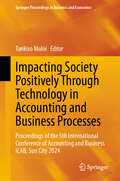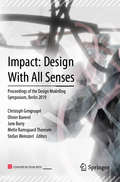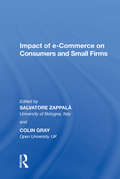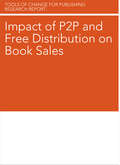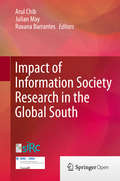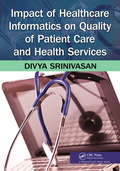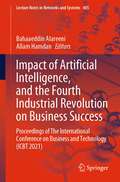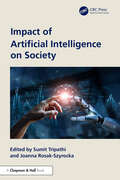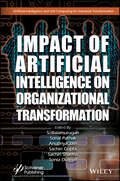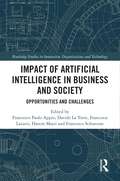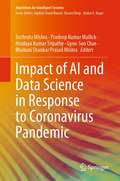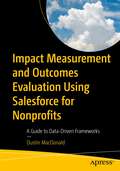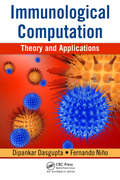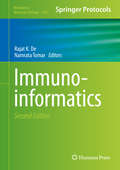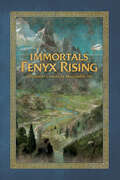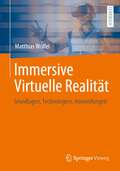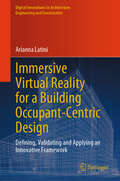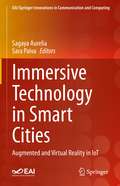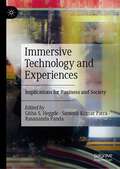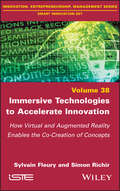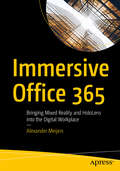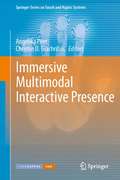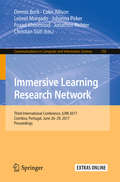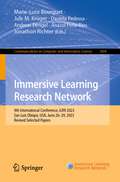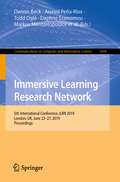- Table View
- List View
Impacting Society Positively Through Technology in Accounting and Business Processes: Proceedings of the 5th International Conference of Accounting and Business iCAB, Sun City 2024 (Springer Proceedings in Business and Economics)
by Tankiso MoloiThis conference volume discusses the findings of the iCAB 2024 conference that took place in Sun City, South Africa, on June 27-28 2024. The University of Johannesburg hosted the iCAB 2024 conference with the aim to bring together researchers from different Accounting and Business Management fields to share ideas and discuss how new disruptive technological developments are impacting the field of accounting. The conference was sponsored by the Association of International Certified Professional Accountants AICPA & CIMA.
Impact: Proceedings of the Design Modelling Symposium, Berlin 2019
by Christoph Gengnagel Jane Burry Mette Ramsgaard Thomsen Stefan Weinzierl Olivier BaverelThis book reflects and expands on the current trend in the building industry to understand, simulate and ultimately design buildings by taking into consideration the interlinked elements and forces that act on them. Shifting away from the traditional focus, which was exclusively on building tasks, this approach presents new challenges in all areas of the industry, from material and structural to the urban scale. The book presents contributions including research papers and case studies, providing a comprehensive overview of the field as well as perspectives from related disciplines, such as computer science. The chapter authors were invited speakers at the 7th Symposium “Impact: Design With All Senses”, which took place at the University of the Arts in Berlin in September 2019.
Impact of e-Commerce on Consumers and Small Firms
by Salvatore ZappalaThe change from old to new technologies has fundamentally changed the relationship between the consumer and the firm. This book is at the frontier of behavioural research into how these new commercial realities are borne out in practice, examining the adoption of e-commerce by small firms and the transactional phenomenon that entails access to the Internet. In analyzing the process of e-commerce adoption and why e-commerce actors behave as they do, its coverage includes the adoption of information and communication technologies (ICT) by small firms; the use of ICT applications to support marketing and sales transactions; and the factors that influence consumers' online purchasing decisions.
Impact of P2P and Free Distribution on Book Sales
by Brian O'LearyBook publishers have long used free content as part of their marketing and selling efforts, with the vast majority of free content distributed in printed form. Digital distribution of free material, either intentional or via unauthorized availability through peer-to-peer sites and other Web outlets, offers a fast and expansive connection to consumers, but content can also be copied and disseminated without publishers' control. Some publishers are torn between the efficiencies digital distribution provides and concerns over piracy and print-sale cannibalization. This research report is part of an ongoing effort by O'Reilly Media Inc. and Random House to test assumptions about free distribution, P2P availability and their potential impact on book sales.
Impact of Information Society Research in the Global South
by Julian May Arul Chib Roxana BarrantesThe second volume in the SIRCA book series investigates the impact of information society initiatives by extending the boundaries of academic research into the realm of practice. Global in scope, it includes contributions and research projects from Asia, Africa and Latin America. The international scholarly community has taken a variety of approaches to question the impact of information society initiatives on populations in the Global South. This book addresses two aspects-- Impact of research: How is the research on ICTs in the Global South playing a role in creating an information society? (e. g. policy formulation, media coverage, implementation in practice) and Research on impact: What is the evidence for the impact of ICTs on society? (i. e. the objectives of socio-economic development). This volume brings together a multiplicity of voices and approaches from social scientific research to produce an engaging volume for a variety of stakeholders including academics, researchers, practitioners, policy-makers and those in the business and civil sectors of society.
Impact of Healthcare Informatics on Quality of Patient Care and Health Services
by Divya Srinivasan SridharRecent healthcare reform and its provisions have pushed health information technology (HIT) into the forefront. Higher life expectancies, fewer medical errors, lower costs, and improved transparency are all possible through HIT.Taking an integrated approach, Impact of Healthcare Informatics on Quality of Patient Care and Health Services examines th
Impact of Artificial Intelligence, and the Fourth Industrial Revolution on Business Success: Proceedings of The International Conference on Business and Technology (ICBT 2021) (Lecture Notes in Networks and Systems #485)
by Allam Hamdan Bahaaeddin AlareeniThis book constitutes the refereed proceedings of the International Conference on Business and Technology (ICBT2021) organized by EuroMid Academy of Business & Technology (EMABT), held in Istanbul, between 06–07 November 2021. In response to the call for papers for ICBT2021, 485 papers were submitted for presentation and inclusion in the proceedings of the conference. After a careful blind refereeing process, 292 papers were selected for inclusion in the conference proceedings from forty countries. Each of these chapters was evaluated through an editorial board, and each chapter was passed through a double-blind peer-review process.The book highlights a range of topics in the fields of technology, entrepreneurship, business administration, accounting, and economics that can contribute to business development in countries, such as learning machines, artificial intelligence, big data, deep learning, game-based learning, management information system, accounting information system, knowledge management, entrepreneurship, and social enterprise, corporate social responsibility and sustainability, business policy and strategic management, international management and organizations, organizational behavior and HRM, operations management and logistics research, controversial issues in management and organizations, turnaround, corporate entrepreneurship, innovation, legal issues, business ethics, and firm gerial accounting and firm financial affairs, non-traditional research, and creative methodologies.These proceedings are reflecting quality research contributing theoretical and practical implications, for those who are wise to apply the technology within any business sector. It is our hope that the contribution of this book proceedings will be of the academic level which even decision-makers in the various economic and executive-level will get to appreciate.
Impact of Artificial Intelligence on Society
by Joanna Rosak-Szyrocka Sumit TripathiThe book presents a comprehensive and interdisciplinary exploration of the impact of AI on various sectors of society to foster a greater understanding of the opportunities and challenges presented by this transformative technology. It explores the impact AI has had on varied sectors of society, including healthcare, education, the workplace, and the economy. It provides a holistic view of this fast-growing technology by critical study of the possible benefits and drawbacks linked with the application of AI in many industries. The book also examines the ethical, social, and economic implications of AI and the potential risks and challenges associated with its use. Focuses on the future influence of AI, providing insights into how it could disrupt several industries and change the way we live, work, and connect with one another Explores how AI can be used to tackle global issues such as climate change, food security, and public health concerns Offers case studies and specific examples of how artificial intelligence is being employed in many industries, covering both successes and failures Investigates cutting-edge technology breakthroughs in AI and how they can be used to improve efficiency, productivity, and performance across multiple industries Understands the limitations and potential biases of artificial intelligence, as well as the significance of human monitoring and accountability The book is intended for researchers, practitioners, policymakers, and students who are interested in understanding the nature and role of AI with regard to different sectors of society.
Impact of Artificial Intelligence on Organizational Transformation (Artificial Intelligence and Soft Computing for Industrial Transformation)
by S. Balamurugan Anupriya Jain Sachin Sharma Sonia Duggal Sachin Gupta Sonal PathakIMPACT OF ARTIFICIAL INTELLIGENCE ON ORGANIZATIONAL TRANSFORMATION Discusses the impact of AI on organizational transformation which is a mix of computational techniques and management practices, with in-depth analysis about the role of automation & data management, and strategic management in relation to human capital, procurement & production, finance, and marketing. The impact of AI in restructuring organizational processes is a combination of management practices and computational technology. This book covers the areas like artificial intelligence & its impact on professions, as well as machine learning algorithms and technologies. The context of applications of AI in business process innovation primarily includes new business models, AI readiness and maturity at the organizational, technological, financial, and cultural levels. The book has extensive details on machine learning and the applications such as robotics, blockchain, Internet of Things. Also discussed are the influence of AI on financial strategies and policies, human skills & values, procurement innovation, production innovation, AI in marketing & sales platforms. Audience Readers include those working in artificial intelligence, business management studies, technology engineers, senior executives, and human resource managers in all types of business.
Impact of Artificial Intelligence in Business and Society: Opportunities and Challenges (Routledge Studies in Innovation, Organizations and Technology)
by Francesco Schiavone Hatem Masri Francesca Lazzeri Francesco Paolo Appio Davide La TorreBelonging to the realm of intelligent technologies, it is increasingly accepted that artificial intelligence (AI) has evolved from being merely a development standpoint in computer science. Indeed, recent reports and academic publications show that we are clearly on the path toward pervasive AI in both business and society. Organizations must adopt AI to maintain a competitive advantage and explore opportunities for unprecedented innovation. This book focuses on understanding the wide range of opportunities as well as the spectrum of challenges AI brings in different business contexts and society at large. The book highlights novel and high-quality research in data science and business analytics and examines the current and future impact of AI in business and society. The authors bridge the gap between business and technical perspectives and demonstrate the potential (and actual) impact on society. Embracing applied, qualitative, and quantitative research as well as field experiments and data analysis, the book covers a broad range of topics including but not limited to human-centered AI, product and process innovation, corporate governance, AI and ethics, organizational performance, and entrepreneurship. This comprehensive book will be a valuable resource for researchers, academics, and postgraduate students across AI, technology and innovation management, and a wide range of business disciplines.
Impact of AI and Data Science in Response to Coronavirus Pandemic (Algorithms for Intelligent Systems)
by Bhabani Shankar Prasad Mishra Pradeep Kumar Mallick Gyoo-Soo Chae Hrudaya Kumar Tripathy Sushruta MishraThe book presents advanced AI based technologies in dealing with COVID-19 outbreak and provides an in-depth analysis of variety of COVID-19 datasets throughout globe. It discusses recent artificial intelligence based algorithms and models for data analysis of COVID-19 symptoms and its possible remedies. It provides a unique opportunity to present the work on state-of-the-art of modern artificial intelligence tools and technologies to track and forecast COVID-19 cases. It indicates insights and viewpoints from scholars regarding risk and resilience analytics for policy making and operations of large-scale systems on this epidemic. A snapshot of the latest architectures, frameworks in machine learning and data science are also highlighted to gather and aggregate data records related to COVID-19 and to diagnose the virus. It delivers significant research outcomes and inspiring new real-world applications with respect to feasible AI based solutions in COVID-19 outbreak. In addition, it discusses strong preventive measures to control such pandemic.
Impact Measurement and Outcomes Evaluation Using Salesforce for Nonprofits: A Guide to Data-Driven Frameworks
by Dustin MacDonaldConduct impact measurement and outcomes evaluation, with a specific focus on nonprofits, using Salesforce Nonprofit Cloud (aka Salesforce for Nonprofits). As funding grows more challenging for nonprofits, having a robust technology system in place allows nonprofits to better seek out funding and receive more when they do. Readers of this book will be better positioned to ensure the long-term success of their organization and make maximum use of their technology. The book begins with an introduction to Salesforce and to Nonprofit Cloud for users who may be new to the platform. Next, you will learn the fundamentals of impact measurement and outcomes evaluation. You will understand why these are important and discover several frameworks that can be used to select outcomes that make sense for your organization to prove that its work is successful. These frameworks include Social Return on Investment (SROI), Cost-Benefit Analysis (CBA), and Pre and Post Comparison (and others). You will use your chosen framework to develop a logic model or theory of change which demonstrates how the work that nonprofits do translates into the outputs and outcomes that clients experience and that nonprofits seek funding to deliver. After covering the theory, author Dustin MacDonald teaches you how to translate the framework you chose into Salesforce. You will learn how to create reports, dashboards, formula fields, roll up summaries, and other basic Salesforce tools in order to collect the information you need to validate your framework. This book also demonstrates how to report on the outcomes you have achieved, tweak results to improve performance, and see the entire end-to-end experience in practice through a set of case studies. The book concludes with a discussion of advanced tools and techniques available inside Salesforce, such as Einstein Prediction Builder, as well as information on how you can immediately apply what you have learned to your own organization. What You Will Learn Understand how to use Nonprofit Cloud to collect and analyze dataKnow how to create a theory of change that shows your impactBecome adept at working with impact measurement frameworksBuild everything you need in Salesforce without writing a single line of codeTurn your insights into new funding to keep your organization strong Who This Book Is For Salesforce administrators, nonprofit staff members, and others working at nonprofits who are required to conduct impact measurement and outcomes evaluation. Additionally, business analysts and technical architects who are designing and implementing solutions for nonprofits at implementation partners will benefit from this book.
Immunological Computation: Theory and Applications
by Dipankar Dasgupta Fernando NinoClearly, nature has been very effective in creating organisms that are capable of protecting themselves against a wide variety of pathogens such as bacteria, fungi, and parasites. The powerful information-processing capabilities of the immune system, such as feature extraction, pattern recognition, learning, memory, and its distributive nature prov
Immunoinformatics
by Rajat K. De Namrata TomarAt the intersection of experimental and computational sciences, the second edition of Immunoinformatics provides biological insights as well as a simpler way to implement approaches and algorithms in the immunoinformatics research domain. After an introductory section, this extensive volume moves on to cover topics such as databases, tools for prediction, systems biology approaches, as well as a variety of immunoinformatics applications. As part of the highly successful Methods in Molecular Biology series, chapters include the type of detailed information and implementation advice to ensure successful results. Comprehensive and practical, Immunoinformatics, Second Edition aims at students and researchers from diverse backgrounds and levels interested in working with immunological problems.
Immortals Fenyx Rising: A Traveler's Guide to the Golden Isle
by Rick Barba UbisoftWelcome to Chryse, the Golden Isle! The king of the gods himself, Zeus, presents you with this indispensable travel guide to the ancient Greek island from Ubisoft&’s Immortals Fenyx Rising video game.Follow the king of the gods on an expedition across the different regions of the dazzling island of Chryse: whether strolling through the lush painted gardens of the goddess Aphrodite, battling inside Ares&’s fortress, or planning a boat trip across the river Styx, this full-color travel guide will keep you alive and thriving. In this glorious hardcover, readers will discover all about each region&’s landmarks, secrets and legendary myths and will enjoy Zeus&’s hot goss on the rest of the pantheon! Immortals Fenyx Rising: A Traveler's Guide to the Golden Isle is a must have for any fan of Immortals Fenyx Rising and Greek mythology.
Immersive Virtuelle Realität: Grundlagen, Technologien, Anwendungen
by Matthias WölfelVollständig realistische Erfahrungen in einer virtuellen Welt anbieten: Darum geht es bei Immersiver Virtueller Realität. Das ausführliche Lehrbuch bietet Studierenden der Informatik, Medien-, Ingenieur- oder Sozialwissenschaften sowie Medienschaffenden und Anwendern immersiver Umgebungen ein anschauliches Nachschlagewerk zu einschlägigen Lehrveranstaltungen oder zum Selbststudium. Dabei adressiert das Buch alle Aspekte immersiver Medien, die für ein ganzheitliches Verständnis relevant sind: Die ersten Kapitel führen in die theoretischen Grundlagen ein. Diese behandeln die verschiedenen Ausprägungender Realität sowie das Metaversum als Zukunftsvision des Internets, geben einen historischen Überblick, beschreiben relevante Sinne und setzen sich mit Interaktion, Interface und Fortbewegung auseinander. Die darauffolgenden Kapitel veranschaulichen die zugrundeliegenden Technologien wie Sensorik, Tracking und Ausgabetechniken einschließlich Stereoskopie und kopfbezogener Übertragungsfunktion. Der letzte Teil des Buches gibt praxisnahe Einblicke in die unterschiedlichen Anwendungsbereiche: Unterhaltung, soziale Interaktion, Lehren und Lernen, Entwicklung sowie soziologische und medientheoretische Forschung.
Immersive Virtual Reality for a Building Occupant-Centric Design: Defining, Validating and Applying an Innovative Framework (Digital Innovations in Architecture, Engineering and Construction)
by Arianna LatiniThis book discusses the cutting-edge intersection of Immersive Virtual Reality (IVR) and research on building occupants. It presents an innovative way of using IVR to revolutionise the comprehension of human-dimension responses to indoor built environments. A robust, innovative, and sequential protocol is defined and validated with a Virtual Environment against a real-world counterpart to provide readers with methodological approaches suitable for carrying out rigorous experimental research in building occupant research. This comprehensive guide provides also practical applications of the proposed guidelines to show the potential and effectiveness of IVR for conducting studies in different indoor environmental conditions in a multi-sensory approach. The book serves as a resource for researchers who want to exploit the full potential of VR in collecting reliable data useful for understanding human dimensions within built environments.
Immersive Technology in Smart Cities: Augmented and Virtual Reality in IoT (EAI/Springer Innovations in Communication and Computing)
by Sara Paiva Sagaya AureliaThis book presents recent trends and enhancements in the convergence of immersive technology and smart cities. The authors discuss various domains such as medical education, construction, brain interface, interactive storytelling, edification, and journalism in relation to combining smart cities, IoT and immersive technologies. The book sets up a medium to promulgate insights and in depth understanding among experts in immersive technologies, IoT, HCI and associated establishments. The book also includes case studies, survey, models, algorithms, frameworks and implementations in storytelling, smart museum, medical education, journalism and more. Various practitioners, academicians and researchers in the domain contribute to the book.
Immersive Technology and Experiences: Implications for Business and Society
by Githa S. Heggde Santosh Kumar Patra Rasananda PandaThis book provides a comprehensive overview of the role of immersive technology with multiple sectoral perspectives, such as entertainment, education, health care, and more. It covers a detailed analysis of the latest trends and developments in the field. It encompasses practical insights on using immersive technology effectively through industry expert chapters, case studies, and real-world examples that demonstrate how immersive technology is being used in different industries. Chapters in this book are from academicians and industry professionals to create a fine balance of knowledge and practice perspective of today’s immersive technology. It is written in accessible language that is easy for non-experts to understand. It focuses on the future of immersive technology, exploring its potential impact on society and the economy. It provides insights into the challenges and opportunities that lie ahead and offers predictions on how immersive technology will continue to evolve in the years to come. It is a valuable resource for anyone learning more about immersive technology.
Immersive Technologies to Accelerate Innovation: How Virtual and Augmented Reality Enables the Co-Creation of Concepts
by Simon Richir Sylvain FleuryThe digital transformation of companies is both a competitive challenge and a complex step for large groups and industries, and at the same time a tremendous opportunity. This transformation is entering a new dimension with the development of immersive technologies such as virtual reality, mixed reality and augmented reality, which are revolutionizing the way we generate content as well as visualize and interact with models and data.The challenges of innovation and digital transformation within companies are now converging. Research shows the potential that immersive technologies have to accelerate the first steps of the innovation process.The objective of this book is to provide a clear vision of the state of research on immersive technologies for design and to deliver practical recommendations for companies wishing to improve their innovation process.
Immersive Office 365: Bringing Mixed Reality and HoloLens into the Digital Workplace
by Alexander MeijersBring mixed reality into your office workplace by building immersive experiences using data and content from your Office 365 platform. Imagine being able to sit at your desk and surround yourself with a 3D chart showing your work relationships as mined from your relationships with others based on how you collaborate together. This book shows you how to access your Office 365 data using the Microsoft Graph API, and then helps you present that data in a 3D modeling visualization using the Microsoft HoloLens 2 as a mixed reality device. This book covers the growing number of tools and techniques you can use to access and visualize data on a Microsoft HoloLens 2 device. Foremost is the Graph API, giving access to the full range of data in Office 365. Also covered are Unity and Visual Studio, the development environments from which you can create mixed reality applications for Microsoft HoloLens 2. You will learn how to load data from and save data to your Office 365 platform based on several interesting use cases. You will be able to extend your digital workplace into a 3D space powered by Microsoft HoloLens 2.Whether you know Office 365 and want to move toward mixed reality, or whether you know the Microsoft HoloLens 2 and want to build functionality around Office 365 data, this book helps you step up and accomplish your goal of bridging between mixed reality and Office 365. What You Will LearnCreate immersive experiences using Microsoft HoloLens 2 and Office 365Access Office 365 data programmatically using the Microsoft Graph APIControl your immersive experiences using natural gestures and eye trackingUnderstand and correctly use different visualization modelsImplement design patterns to write better code in UnityKnow how to access services using web requests via DLLsWho This Book Is ForDevelopers who want to expand their knowledge of the Office 365 platform into the world of mixed reality by creating immersive experiences and 3D visualizations using the Microsoft HoloLens 2 and similar devices, and mixed reality developers who want to extend their repertoire toward serving everyday business needs of workers in corporate office environments
Immersive Multimodal Interactive Presence
by Angelika Peer Christos D. GiachritsisImmersive Multimodal Interactive Presence presents advanced interdisciplinary approaches that connect psychophysical and behavioral haptics research with advances in haptic technology and haptic rendering. It delivers a summary of the results achieved in the IMMERSENCE European project and includes selected chapters by international researchers. Organized into two parts: I. Psychophysical and Behavioral Basis and II. Technology and Rendering, it is an excellent example of interdisciplinary research directed towards the advancement of multimodal immersive virtual environments with particular focus on haptic interaction. The twelve chapters of the book are grouped around three different scenarios representing different types of interactions in virtual environments: Person-Object (PO), Person-Object-Person (POP) and Person-Person (PP) interaction. Recent results of psychophysical and behavioral studies are reported along with new technological developments for haptic displays and novel haptic rendering techniques.
Immersive Learning Research Network: Third International Conference, iLRN 2017, Coimbra, Portugal, June 26–29, 2017. Proceedings (Communications in Computer and Information Science #725)
by Colin Allison Leonel Morgado Johanna Pirker Dennis Beck Jonathon Richter Christian Gütl Foaad KhosmoodThis book constitutes the refereed proceedings of the Second International Conference of the Immersive Learning Network, iLRN 2016, held in Santa Barbara, CA, USA, in June/July 2016. The proceedings contain 9 full papers carefully reviewed and selected from 45 submissions and the best 5 special track papers. The papers focus on various applications of immersive technologies to learning.
Immersive Learning Research Network: 9th International Conference, iLRN 2023, San Luis Obispo, USA, June 26–29, 2023, Revised Selected Papers (Communications in Computer and Information Science #1904)
by Jonathon Richter Anasol Peña-Rios Andreas Dengel Marie-Luce Bourguet Jule M. Krüger Daniela PedrosaThis volume constitutes the refereed proceedings of the 9th International Conference of the Immersive Learning Network, iLRN 2023, held in San Luis Obispo, USA, in June 2023 as a hybrid event.The 26 revised full papers and 13 shprt papers presented in this volume were carefully reviewed and selected from 110 submissions. The papers are organized in topical sections on foundations in immersive learning research and theory; assessment and evaluation; galleries, libraries, archives and museums; inclusion, diversity, equity, access, and social justice; STEM education; language, culture and heritage; nature & environmental sciences; workforce development & industry training; self and co-regulated learning with immersive learning environments; special track: immersive learning across Latin America: state of research, use cases and projects.
Immersive Learning Research Network: 5th International Conference, iLRN 2019, London, UK, June 23–27, 2019, Proceedings (Communications in Computer and Information Science #1044)
by Leonel Morgado Johanna Pirker Dennis Beck Jonathon Richter Christian Gütl Anasol Peña-Rios Todd Ogle Daphne Economou Markos Mentzelopoulos Christian Eckhardt Roxane Koitz-Hristov Michael GardnerThis volume constitutes the refereed proceedings of the 5th International Conference of the Immersive Learning Network, iLRN 2019, held in London, UK, in June 2019.The 18 revised full papers and presented in this volume were carefully reviewed and selected from 60 submissions. The papers are organized in topical sections on science, technology, engineering, and mathematics (STEM); disciplinary applications: special education; disciplinary applications: history; pedagogical strategies; immersion and presence.
